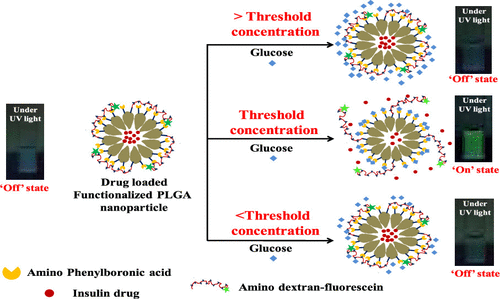当前位置:
X-MOL 学术
›
ACS Biomater. Sci. Eng.
›
论文详情
Our official English website, www.x-mol.net, welcomes your
feedback! (Note: you will need to create a separate account there.)
Surface Engineered PLGA Nanoparticle for Threshold Responsive Glucose Monitoring and “Self-Programmed” Insulin Delivery
ACS Biomaterials Science & Engineering ( IF 5.4 ) Pub Date : 2021-08-23 , DOI: 10.1021/acsbiomaterials.1c00830 Gaurav Ranjan Dey 1 , Arindam Saha 1
ACS Biomaterials Science & Engineering ( IF 5.4 ) Pub Date : 2021-08-23 , DOI: 10.1021/acsbiomaterials.1c00830 Gaurav Ranjan Dey 1 , Arindam Saha 1
Affiliation

|
We have developed a reversible, biocompatible, “self-programmed” PLGA [poly(lactic-co-glycolic acid)] nanoparticle-based optical biosensor capable of sensing and continuous monitoring of glucose above the physiologically relevant threshold value (100–125 mg/dL) as well as “on-demand” insulin delivery via an “On–Off” technique. We have carefully surface engineered the PLGA nanoparticle using amino dextran-fluorescein (A-DexFl) and amino-phenyl boronic acid (A-PBA) to exploit the binding affinity of boronic acids with that of cis-1,2 diols of dextran/glucose. Initially, the dextran chains wrap the nanoparticle surface due to its high affinity toward A-PBA (Kb = 6.1 × 106 M–1). The close proximity of the fluorophores with that of A-PBA quenches the fluorescence, resulting in an “Off” state. On the addition of glucose, it competes with A-DexFl to bind with A-PBA. Above a certain threshold concentration of glucose, the binding affinity overcomes (Kb = 6.3 × 107 M–1) the dextran-A-PBA binding. This opens-up the wrapped A-DexFl chains from the nanoparticle surface and results in an increased distance between the fluorophore and A-PBA, triggering the “On” state. The activation of the On–Off state can be finely tuned in the desired range of physiologically relevant glucose concentrations by varying the ligand ratios on the PLGA surface. The nanoparticle core has also been used as an insulin reservoir to trigger the drug release in the “On” state. We have obtained ∼53% encapsulation efficiency and ∼20% loading efficiency for insulin loading. Once the glucose concentration falls beyond the detection range, the dextran chains collapse on the nanoparticle surface with a suspension in drug release. The process is solely controlled by the competition and multivalent binding affinity between glucose, A-DexFl, and A-PBA, which allows it to be “self-programmed” and “self-regulated” with continuous monitoring up to 8–10 cycles over a 72 h time period. A sustained drug release has been found with ∼70% of released drug over a period of 72 h, although this release is insignificant in the absence of glucose. Several control experiments have been performed to optimize the sensor design.
中文翻译:

用于阈值响应葡萄糖监测和“自编程”胰岛素输送的表面工程 PLGA 纳米颗粒
我们开发了一种可逆的、生物相容的、“自编程的”PLGA [聚(乳酸-共-乙醇酸)] 纳米粒子光学生物传感器,能够感应和连续监测高于生理相关阈值(100-125 毫克/ dL) 以及通过“开-关”技术的“按需”胰岛素输送。我们使用氨基葡聚糖-荧光素 (A-DexFl) 和氨基-苯基硼酸 (A-PBA) 对 PLGA 纳米颗粒进行了仔细的表面工程,以利用硼酸与葡聚糖/葡萄糖的顺式-1,2 二醇的结合亲和力. 最初,葡聚糖链由于其对 A-PBA 的高亲和力(K b = 6.1 × 10 6 M –1)。荧光团与 A-PBA 的荧光团非常接近会淬灭荧光,导致“关闭”状态。添加葡萄糖后,它与 A-DexFl 竞争与 A-PBA 结合。高于一定的葡萄糖阈值浓度,结合亲和力克服(K b = 6.3 × 10 7 M –1) 葡聚糖-A-PBA 结合。这会从纳米颗粒表面打开包裹的 A-DexFl 链,并导致荧光团和 A-PBA 之间的距离增加,从而触发“开启”状态。通过改变 PLGA 表面上的配体比例,可以在生理相关葡萄糖浓度的所需范围内微调 On-Off 状态的激活。纳米颗粒核心还被用作胰岛素储存器,以在“开启”状态下触发药物释放。我们已经获得了约 53% 的包封效率和约 20% 的胰岛素装载效率。一旦葡萄糖浓度超出检测范围,葡聚糖链就会在纳米颗粒表面坍塌,并在药物释放中形成悬浮液。该过程完全由葡萄糖、A-DexFl、和 A-PBA,它允许它“自我编程”和“自我调节”,并在 72 小时的时间段内连续监测多达 8-10 个周期。已经发现在 72 小时内释放出约 70% 的药物会持续释放药物,尽管这种释放在没有葡萄糖的情况下是微不足道的。已经进行了几个控制实验来优化传感器设计。
更新日期:2021-09-13
中文翻译:

用于阈值响应葡萄糖监测和“自编程”胰岛素输送的表面工程 PLGA 纳米颗粒
我们开发了一种可逆的、生物相容的、“自编程的”PLGA [聚(乳酸-共-乙醇酸)] 纳米粒子光学生物传感器,能够感应和连续监测高于生理相关阈值(100-125 毫克/ dL) 以及通过“开-关”技术的“按需”胰岛素输送。我们使用氨基葡聚糖-荧光素 (A-DexFl) 和氨基-苯基硼酸 (A-PBA) 对 PLGA 纳米颗粒进行了仔细的表面工程,以利用硼酸与葡聚糖/葡萄糖的顺式-1,2 二醇的结合亲和力. 最初,葡聚糖链由于其对 A-PBA 的高亲和力(K b = 6.1 × 10 6 M –1)。荧光团与 A-PBA 的荧光团非常接近会淬灭荧光,导致“关闭”状态。添加葡萄糖后,它与 A-DexFl 竞争与 A-PBA 结合。高于一定的葡萄糖阈值浓度,结合亲和力克服(K b = 6.3 × 10 7 M –1) 葡聚糖-A-PBA 结合。这会从纳米颗粒表面打开包裹的 A-DexFl 链,并导致荧光团和 A-PBA 之间的距离增加,从而触发“开启”状态。通过改变 PLGA 表面上的配体比例,可以在生理相关葡萄糖浓度的所需范围内微调 On-Off 状态的激活。纳米颗粒核心还被用作胰岛素储存器,以在“开启”状态下触发药物释放。我们已经获得了约 53% 的包封效率和约 20% 的胰岛素装载效率。一旦葡萄糖浓度超出检测范围,葡聚糖链就会在纳米颗粒表面坍塌,并在药物释放中形成悬浮液。该过程完全由葡萄糖、A-DexFl、和 A-PBA,它允许它“自我编程”和“自我调节”,并在 72 小时的时间段内连续监测多达 8-10 个周期。已经发现在 72 小时内释放出约 70% 的药物会持续释放药物,尽管这种释放在没有葡萄糖的情况下是微不足道的。已经进行了几个控制实验来优化传感器设计。











































 京公网安备 11010802027423号
京公网安备 11010802027423号